Optimal Placement and Sizing of Distributed PV-Storage in Distribution Networks Using Cluster-Based Partitioning
Abstract
1. Introduction
2. Analysis of DPV and ESS Hierarchical Planning Strategies
2.1. Cluster Division and Method
- (1)
- Cluster refers to a group of nodes and interconnecting branches with similar spatial locations, strong electrical coupling, balanced local supply and demand of reactive power, and complementary active power timing. In the structure of the distribution network, nodes are crucial locations for power transmission and distribution, and branches play the role of connecting different nodes to enable power transmission.
- (2)
- Cluster Partition, according to the spatial index, structure index, function index, and other comprehensive index criteria, the distribution system is partitioned into multiple group structures.
2.2. Configure ESS Mode for Cohorts
2.3. Distribution Network-Cluster-Node Hierarchical Planning Strategy
2.3.1. Cluster Partition Result
2.3.2. Upper-Level Planning—With Clusters as the Basic Unit
2.3.3. Lower-Level Planning (Node-Based)
3. DPV and ESS Siting and Capacity Bi-Level Planning Model
3.1. Two-Tier Planning Architecture
3.2. Upper-Level Planning Model
3.2.1. Objective Function
- (1)
- Equal yearly installation expense.
- (2)
- Annual operation and maintenance costs.
- (3)
- DPV annual power generation subsidy.
- (4)
- The expenditure for electricity sourced from the primary network.
3.2.2. Constraints
- (1)
- The DPV capacity constraints that cluster j allows to be installed.
- (2)
- Power balance constraints.
- (3)
- Mainnet liaison branch reversing power constraint.
- (4)
- Inter-group interactive branch power constraints.
- (5)
- DPV active output constraint, i.e., the DPV output power is less than the rated capacity of the installation.
- (6)
- ESS charge–discharge power and state-of-charge constraints.
3.3. Lower-Level Planning Model
3.3.1. Objective Function
3.3.2. Constraints
- (1)
- The DPV capacity constraint of each node in the cluster j.
- (2)
- The DPV capacity constraints that node i allows for installation.
- (3)
- Distribution network power flow constraints.
- (4)
- Node i voltage constraints.
- (5)
- Branch l power constraint.
4. Solving Algorithm for the Two-Level Programming Model
4.1. A Two-Layer Iterative Hybrid Particle Swarm Algorithm Embedded in Power Flow Computing
4.2. Optimize the Algorithm Process
- (1)
- Step 1: Initialization. Enter the distribution network’s original data to be planned, perform the initial power flow calculation, obtain the branch tidal current and node voltage data, and initialize the algorithm parameters.
- (2)
- Step 2: Initialize the upper particle swarm. Based on the value range of the upper-level programming decision variables, initialize the swarm’s velocity, position, individual optimal value, and population optimal value; set the current iteration count to iteru = 0.
- (3)
- Step 3: The upper-layer particle swarm is updated. Update the velocity and position of the upper-layer particles, and determine if the updated value satisfies the condition: if the velocities before and after the update are the same, multiply the current velocity by a random number between (0,1); if the updated position is out of bounds, the out-of-bounds particles are processed by using the boundary variation strategy of spatial scaling and attractor [22], and the number of iterations iteru is updated to iteru + 1.
- (4)
- Step 4: Lower Optimization. Follow these steps:
- Initialize the underlying particle swarm. Based on the upper particles, initialize the velocity and position of the lower particles for each cluster, set the individual and group optimal values, and set the iteration count (iter) to 0.
- Update the lower particle swarm. Update the particles for DPV capacity at each node in the lower layer (step 3) and optimize the ESS position using the binary particle swarm formula. Increment the iteration count (iter) by 1.
- Evaluate the fitness of the lower particles. Using the lower-layer particle data, update the DPV output and ESS charge/discharge power at each node in the power flow program, then perform power flow calculations to determine the fitness of the lower subgroups.
- Update the individual and population optimal values and fitness of the lower particle swarm. The swarm’s fitness was compared with the corresponding individual optimal fitness, and the optimal values and fitness were updated. Moreover, the individual optimal value and individual optimal fitness were updated. Then, the individual optimal fitness was compared with the current population optimal fitness, and the population optimal value and group optimal fitness were updated.
- Judgment on the number of iterations. Determine whether the condition iter < max iter (max iter = max iteru/10) is satisfied, and if so, return 2); otherwise, the current population optimal value and fitness are used as optimization results, and step 5 is turned.
- (5)
- Step 5: Calculate the fitness of the upper particles. Based on the current population particle data, the particle fitness is obtained.
- (6)
- Step 6: Update the individual and population optimal values and fitness of the upper particle swarm. Same as step 4.
- (7)
- Step 7: The number of iterations is checked. If the condition iteru < max iteru is met, return to step 3; otherwise, output the results of double-layer sitting and capacity optimization.
4.3. Operational Performance Evaluation Index
- (1)
- Improved self-balancing degree SA,j:
- (2)
- Energy permeability SEP: the ratio of the annual output of the DPV in the cluster to the annual power demand of the load in the cluster, reflecting the cumulative effect of the DPV output to the load.
- (3)
- Capacity permeability SCP: the ratio of the annual maximum DPV output to the annual maximum load in the cluster, reflecting the saturation degree of DPV capacity and its limit.
- (4)
- Power permeability SPP: the annual maximum ratio of DPV output to load. It reflects the maximum proportion of load electricity demand that DPV power can meet within a cluster during a specific planning period and demonstrates the upper limit of the supporting capacity of distributed PV power sources for local loads.
5. System Examples and Result Analysis
5.1. Simulation Verification of a Typical IEEE33 Node System
5.1.1. The Clustering Results of the Typical IEEE33 Bus System
5.1.2. Optimize the Configuration Result
5.1.3. Sensitivity Analysis
- (1)
- The impact of PV permeability changes on system costs
- (2)
- The impact of changes in electricity price levels on optimal allocation
5.2. Overview of Actual System Examples
5.3. Case Results and Case Comparison Analysis
5.3.1. DPV and ESS Site Selection and Capacity Planning Scheme
5.3.2. Upper-Level Planning Results
5.3.3. Lower-Level Planning Results
5.4. Analysis of Planning Performance Evaluation Indicators
5.5. Analysis of the Impact of ESS Type on Planning Results
5.6. Analysis of Algorithm Performance
6. Conclusions
6.1. Research Work Summary
- (1)
- The proposed approach configures the ESS based on clusters, effectively addressing the timing mismatch between DPV output and load demand. In the case study of the 10 kV distribution system, compared with Scenario 1 (non-clustered single-layer planning model), the total DPV capacity connected to the distribution network in Scenario 3 (cluster-based two-layer planning model) increased by 26%. Meanwhile, the cost of purchasing electricity from the main network decreased by 135,600 yuan. This indicates that the approach enhances the distribution network’s capacity to integrate DPV by 26%, reduces the strain on the main network and tie lines, and ultimately improves the economic performance of the distribution network’s operation.
- (2)
- The proposed method incorporates zoning during the planning phase, which brings significant improvements. In Scenario 3, compared with the original system, the annual intra-group network losses of clusters 1–3 decreased to 63.03%, 69.05%, and 71.67% of the original system, respectively, and the inter-group branch network losses decreased to 47.59–63.65% of the original system. During 7:00–18:00 of a typical day, the proportion of system network losses and power losses in Scenario 3 decreased significantly. At 13:00, the proportion of system network losses decreased to 37.06% of the original system, and the proportion of power losses decreased to 72.69% of the original system. Also, the minimum node voltage increased from 0.977 before planning to 0.985 in Scenario 3, and the voltage fluctuation index decreased by 13.67% compared with that before planning. Additionally, the hierarchical planning in Scenario 3 converges faster with fewer iterations, greatly boosting the optimization efficiency.
- (3)
- The configuration results of each scheme are compared from the two levels of distribution network and cluster using comprehensive indicators. At the cluster level, in terms of the self-balancing indicator, the self-balancing degree of each cluster in Scenario 3 is relatively high, ranging stably between 0.15 and 0.35, and it is evenly distributed among clusters. In contrast, in Scenario 1, only cluster 3, and in Scenario 2, only clusters 5 and 6 have relatively high self-balancing degrees, while others are low with large distribution differences. For the Energy permeability, Capacity permeability, and Power permeability indicators, the DPV penetration rate in Scenario 3 is relatively high and evenly distributed among clusters. For example, in the Capacity permeability indicator, the values of each cluster in Scenario 3 do not exceed the critical value of 1, indicating a more reasonable configuration. At the distribution network level, Scenario 3 shows the best performance in indicators such as self-balancing rate, energy permeability, capacity permeability, and power permeability. The comparison results verify that the proposed cluster-based planning method can effectively improve the autonomy of the cluster and distribution system.
6.2. Outlook for Follow-Up Work
- (1)
- In view of the various uncertainty factors in the division of distributed generation clusters and the planning of distributed power sources, it is necessary to use the uncertainty theory to systematically analyze their influence on the complexity of distribution network operation and control and the planning results, and it is important to deeply improve the index system and division method of cluster division, as well as the optimization model and solution algorithm of power source planning.
- (2)
- In the uncertainty scenario, there is a strong coupling relationship between the division of distributed generation clusters and the optimal planning of distributed power sources. It is necessary to further explore the internal connection between the two and combine the operation performance requirements of the distribution network to achieve the collaborative optimization of cluster division and power source planning.
- (3)
- The comprehensive optimization problem of distributed generation cluster division and power source planning considering uncertainty has the characteristics of numerous parameters and complex models. Its solution needs to be completed through alternating iteration, which requires high computing power of the algorithm and has the disadvantage of long solution time. Therefore, it is urgent to explore efficient and accurate solution strategies.
Author Contributions
Funding
Data Availability Statement
Conflicts of Interest
Appendix A
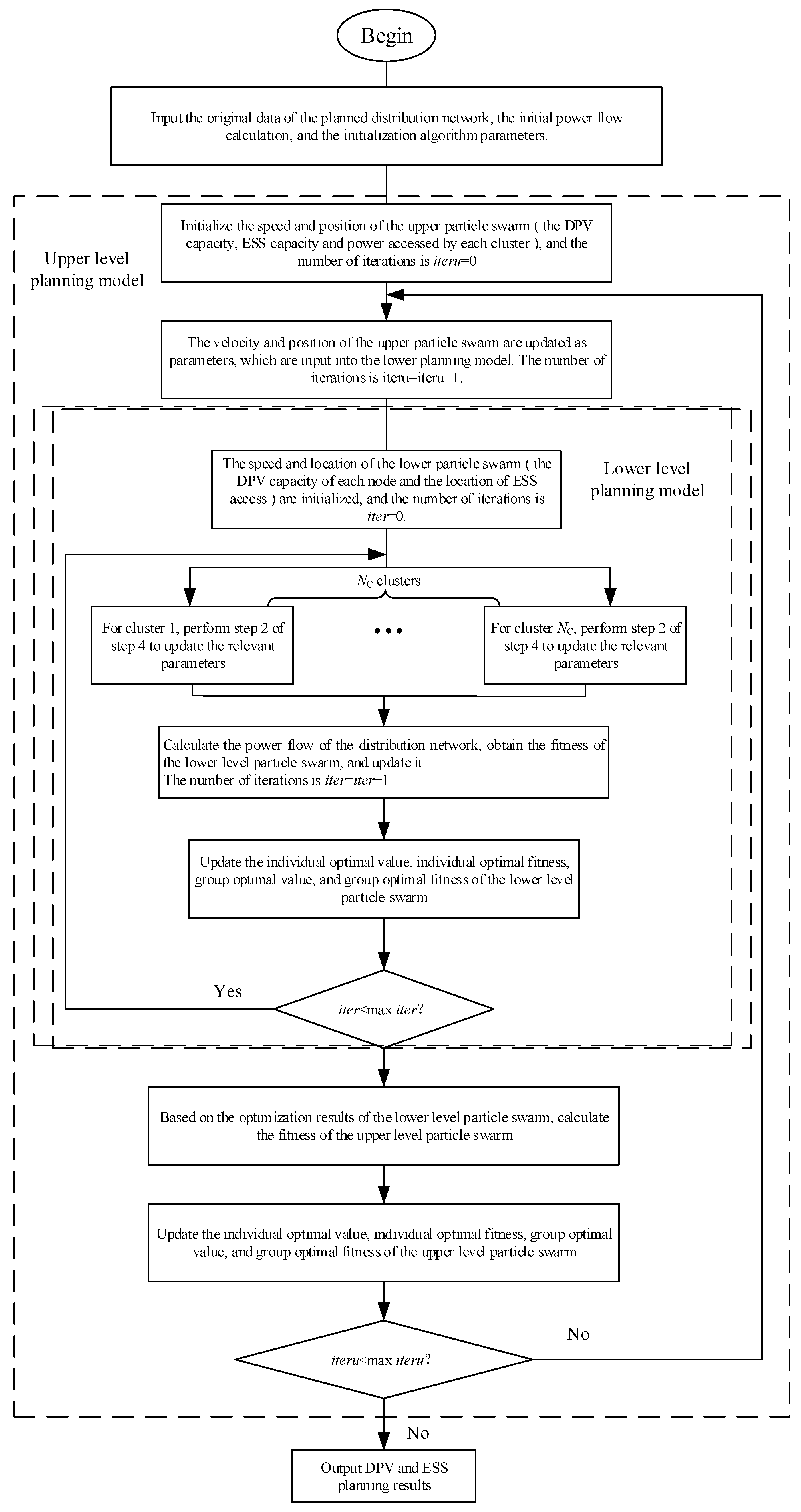
| Parameter | Valid Values | Parameter | Valid Values |
|---|---|---|---|
| The unit capacity investment cost of DPV/(Yuan/kW) | 5500 | The upper limit of the SOC of NaS | 0.8 |
| The operation and maintenance cost of DPV per unit of electricity generated/(Yuan/kW·h) | 0.3 | The lower SOC limit of NaS | 0.2 |
| DPV service life/year | 20 | Charging efficiency of NaS | 0.9 |
| Investment cost per unit capacity of NaS/(Yuan/kW) | 1260 | Discharge efficiency of NaS | 0.9 |
| Investment cost per unit power of NaS/(Yuan/kW·h) | 1700 | discount rate | 0.06 |
| Operation and maintenance costs per unit of NaS power generation/(Yuan/kW·h) | 0.08 | Photovoltaic power generation subsidy/(Yuan/kW·h) | 0.42 |
| NaS service life/year | 15 | The price of electricity purchased on the main network/(Yuan/kW·h) | 0.55 |
| Parameter | NaS | VRB | PSB | VRLA | Li-Ion |
|---|---|---|---|---|---|
| Investment cost per unit of power/(Yuan/kW) | 1650 | 2815 | 1060 | 1980 | 2830 |
| Investment cost per unit capacity/(Yuan/kW·h) | 1270 | 660 | 460 | 980 | 1390 |
| O&M costs per unit of power generation/(Yuan/kW·h) | 0.080 | 0.080 | 0.080 | 0.093 | 0.087 |
| Charge–discharge efficiency | 0.80 | 0.70 | 0.60 | 0.85 | 0.90 |
| Service life/year | 15 | 15 | 15 | 10 | 15 |
| Planned Scenarios | Cluster 1 | Cluster 2 | Cluster 3 | Cluster 4 | Cluster 5 | Cluster 6 | Cluster 7 | Cluster 8 | Distribution Grids | |
|---|---|---|---|---|---|---|---|---|---|---|
| NaS | PV capacity/kW | 75.723 | 29.146 | 100.715 | 26.236 | 115.155 | 90.560 | 80.205 | 40.921 | 564.652 |
| ESS capacity/(kW·h) | 35.657 | 19.254 | 16.542 | 5.541 | 70.714 | 60.546 | 38.145 | 25.547 | 250.375 | |
| ESS power/kW | 12.031 | 9.734 | 6.045 | 2.651 | 21.175 | 22.916 | 15.450 | 7.755 | 92.572 | |
| VRB | PV capacity/kW | 84.546 | 35.145 | 100.254 | 40.328 | 168.554 | 98.362 | 81.531 | 44.151 | 687.268 |
| ESS capacity/(kW·h) | 76.026 | 22.414 | 25.658 | 53.785 | 283.348 | 86.955 | 45.448 | 30.648 | 604.623 | |
| ESS power/kW | 16.715 | 7.211 | 7.529 | 16.315 | 63.246 | 22.784 | 15.616 | 8.675 | 161.785 | |
| PSB | PV capacity/kW | 141.457 | 50.476 | 128.271 | 20.273 | 371.271 | 160.812 | 88.543 | 88.257 | 1003.726 |
| ESS capacity/(kW·h) | 465.426 | 162.351 | 110.397 | 3.135 | 1217.814 | 445.736 | 78.508 | 358.661 | 2928.325 | |
| ESS power/kW | 109.42 | 30.102 | 36.545 | 1.227 | 243.941 | 91.757 | 23.262 | 81.541 | 589.654 | |
| VRLA | PV capacity/kW | 70.494 | 29.587 | 96.474 | 26.485 | 105.521 | 89.556 | 71.991 | 46.546 | 557.706 |
| ESS capacity/(kW·h) | 15.257 | 13.785 | 14.562 | 3.458 | 65.796 | 52.980 | 20.560 | 23.856 | 209.861 | |
| ESS power/kW | 7.594 | 6.652 | 4.892 | 1.978 | 22.061 | 18.789 | 6.168 | 7.368 | 75.048 | |
| Li-ion | PV capacity/kW | 70.481 | 29.175 | 95.632 | 25.872 | 114.872 | 92.766 | 66.648 | 46.142 | 541.948 |
| ESS capacity/(kW·h) | 15.726 | 13.258 | 10.782 | 2.483 | 64.004 | 62.339 | 4.700 | 21.659 | 193.448 | |
| ESS power/kW | 8.001 | 7.116 | 3.252 | 2.108 | 23.076 | 21.636 | 2.538 | 7.178 | 74.958 | |
References
- Ding, M.; Xu, Z.; Wang, W.; Wang, X.; Song, Y.; Chen, D. A review on China’s large-scale PV integration: Progress, challenges and recommendations. Renew. Sustain. Energy Rev. 2016, 53, 639–652. [Google Scholar] [CrossRef]
- Ding, M.; Wang, W.; Wang, X.; Song, Y.T.; Chen, D.Z.; Sun, M. A review on the effect of large-scale PV generation on power systems. Proc. CSEE (In Chinese). 2014, 34, 1–14. [Google Scholar]
- Zhang, S.; Li, K.; Cheng, H.; Bazargan, M.; Yao, L. Optimal siting and sizing of intermittent distributed generator considering correlations. Autom. Electr. Power Syst. 2015, 39, 53–58. (In Chinese) [Google Scholar]
- Li, Z.; Chen, S.Y.; Fu, Y.; Dong, C.M.; Zhang, J.W. Optimal allocation of ESS in distribution network containing DG base on timing-voltage-sensitivity analysis. Proc. CSEE 2017, 37, 4630–4640. (In Chinese) [Google Scholar]
- Wang, K.; Wang, C.; Yao, W.; Zhang, Z.; Liu, C.; Dong, X.; Yang, M.; Wang, Y. Embedding P2Ptransaction into demand response exchange: A cooperative demand response management framework for IES. Appl. Energy 2024, 367, 123319. [Google Scholar] [CrossRef]
- Zhang, Z.; Hui, H.; Song, Y. Response Capacity Allocation of Air Conditioners for Peak Valley Requlation Considering Interaction with Surrounding Microclimate. IEEE Trans. Smart Grid 2025, 16, 1155–1167. [Google Scholar] [CrossRef]
- Tong, H.; Zeng, X.; Yu, K.; Zhou, Z. A Fault ldentification Method for Animal Electric Shocks Considering Unstable Contact Situations in Low-Voltage Distribution Grids. IEEE Trans. Indnform. 2025, 21, 4039–4050. [Google Scholar]
- Xia, Y.; Li, Z.; Xi, Y.; Wu, G.; Peng, W.; Mu, L. Accurate Fault Location Method for Multiple Faults in Transmission Networks Using Travelling Waves. IEEE Trans. Ind. Inform. 2024, 20, 8717–8728. [Google Scholar] [CrossRef]
- Li, L.; Tang, W.; Bai, M.; Zhang, L.; Lu, T. Multi-objective locating and sizing of distributed generators based on time-sequence characteristics. Autom. Electr. Power Syst. 2013, 37, 58–63. (In Chinese) [Google Scholar]
- Li, K.; Tai, N.; Zhang, S.; Chen, X. Multi-objective planning method of distributed generators considering correlations. Autom. Electr. Power Syst. 2017, 41, 51–57. (In Chinese) [Google Scholar]
- Zhang, S.; Cheng, H.; Li, K.; Bazargan, M.; Yao, L. Optimal siting and sizing of intermittent distributed generators in distribution system. IEEJ Trans. Electr. Electron. Eng. 2015, 10, 628–635. [Google Scholar] [CrossRef]
- Giannitrapani, A.; Paoletti, S.; Vicino, A.; Zarrilli, D. Optimal allocation of energy storage systems for voltage control in LV distribution networks. IEEE Trans. Smart Grid 2017, 8, 2859–2870. [Google Scholar] [CrossRef]
- Muke, B.; Wei, T.; Huang, T. Optimal PV-generation & ES configuration based on virtual partition scheduling and bi-level programming for urban distribution network. Electr. Power Autom. Equip. 2016, 36, 141–148. (In Chinese) [Google Scholar]
- Zheng, L.; Hu, W.; Lu, Q.; Min, Y.; Yuan, F.; Gao, Z.H. Research on planning and operation model for energy storage system to optimize wind power integration. Proc. CSEE 2014, 34, 2533–2543. (In Chinese) [Google Scholar]
- Zhao, B.; Xu, Z.; Xu, C.; Wang, C.; Lin, F. Network partition-based zonal voltage control for distribution networks with distributed PV systems. IEEE Trans. Smart Grid 2018, 9, 4087–4098. [Google Scholar] [CrossRef]
- Ding, M.; Liu, X.; Bi, R.; Hu, D.; Ye, B.; Zhang, J. Method for cluster partition of high-penetration distributed generators based on comprehensive performance index. Autom. Electr. Power Syst. 2018, 42, 47–52. (In Chinese) [Google Scholar]
- Yu, L.; Sun, Y.; Xu, R.; Li, K. Improved particle swarm optimization algorithm and its application in reactive power partitioning of power grid. Autom. Electr. Power Syst. 2017, 41, 89–95. (In Chinese) [Google Scholar]
- Wei, Z. Overview of complex networks community structure and its applications in electric power network analysis. Proc. CSEE 2015, 35, 1567–1577. (In Chinese) [Google Scholar]
- Xue, F.; Chang, K.; Wang, N. Coordinated control frame of large-scale intermittent power plant cluster. Autom. Electr. Power Syst. 2011, 35, 45–53. (In Chinese) [Google Scholar]
- Liu, H.; Fan, B.Y.; Tang, C.; Ge, S.Y.; Wang, Y.; Guo, L. Game theory based alternate optimization between expansion planning of active distribution system and siting and sizing of photovoltaic and energy storage. Autom. Electr. Power Syst. 2017, 41, 38–45. (In Chinese) [Google Scholar]
- Wu, X.; Liu, Z.; Tian, L.; Ding, D.; Yang, S. Energy storage device locating and sizing for distribution network based on improved multi-objective particle swarm optimizer. Power Syst. Technol. 2014, 38, 3405–3411. (In Chinese) [Google Scholar]
- Chi, Y.H.; Sun, F.C.; Wang, W.J.; Yu, C.M. An improved particle swarm optimization algorithm with search space zoomed factor and attractor. Chin. J. Comput. 2011, 34, 115–130. (In Chinese) [Google Scholar] [CrossRef]
- Ding, M.; Liu, X.; Xie, J.; Pan, H. Optimal planning model of grid-connected microgrid considering comprehensive performance. Power Syst. Prot. Control 2017, 45, 18–26. (In Chinese) [Google Scholar]
- Zhao, B.; Xiao, C.; Xu, C.; Zhang, X.; Zhou, J. Penetration based accommodation capacity analysis on distributed photovoltaic connection in regional distribution network. Autom. Electr. Power Syst. 2017, 41, 105–111. (In Chinese) [Google Scholar]
- Xiang, Y.; Wei, Z.; Sun, G.; Sun, Y.H.; Shen, H.P. Life cycle cost based optimal configuration of battery energy storage system in distribution network. Power Syst. Technol. 2015, 39, 264–270. (In Chinese) [Google Scholar]
- Li, P.; Hua, H.; Chen, A.W.; Di, K. Source-load storage coordination partition optimal economic operation of AC/DC hybrid microgrid based on bilevel programming model. Proc. CSEE 2016, 36, 6769–6779. (In Chinese) [Google Scholar]

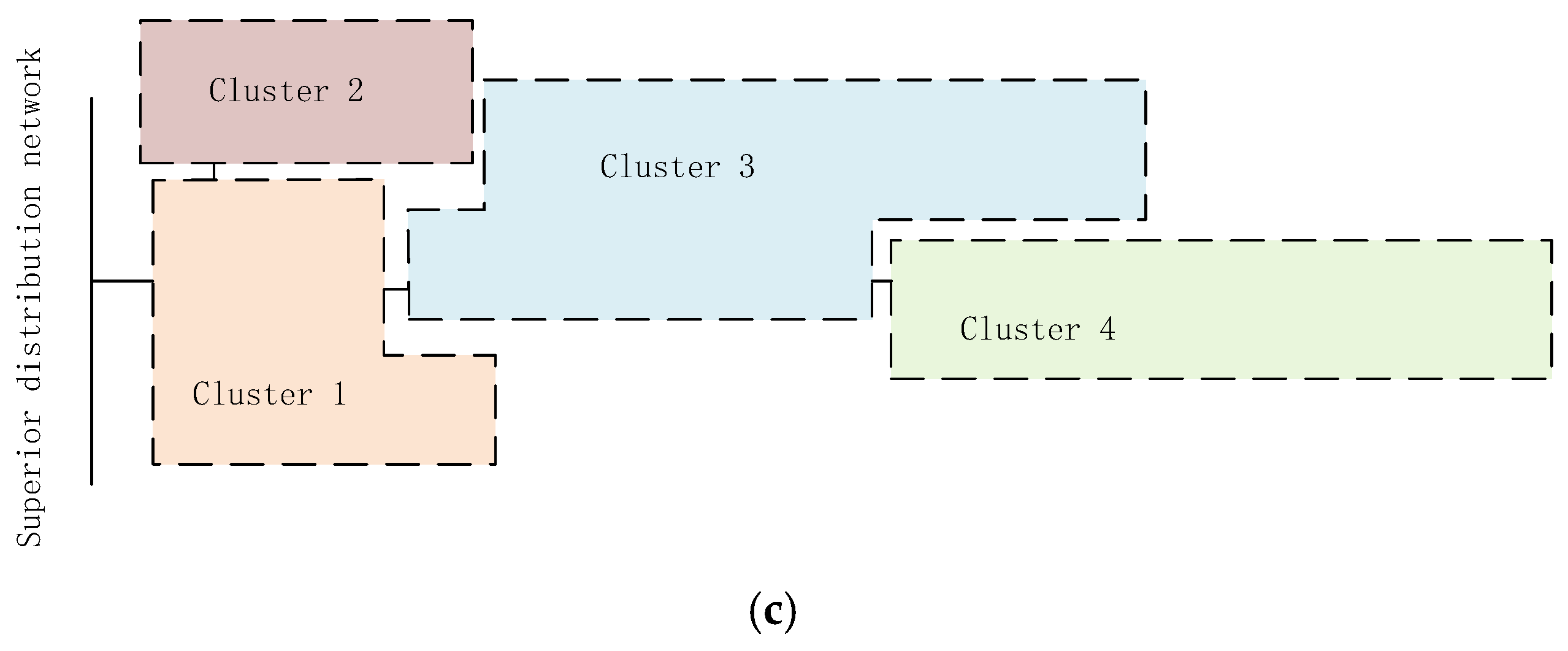

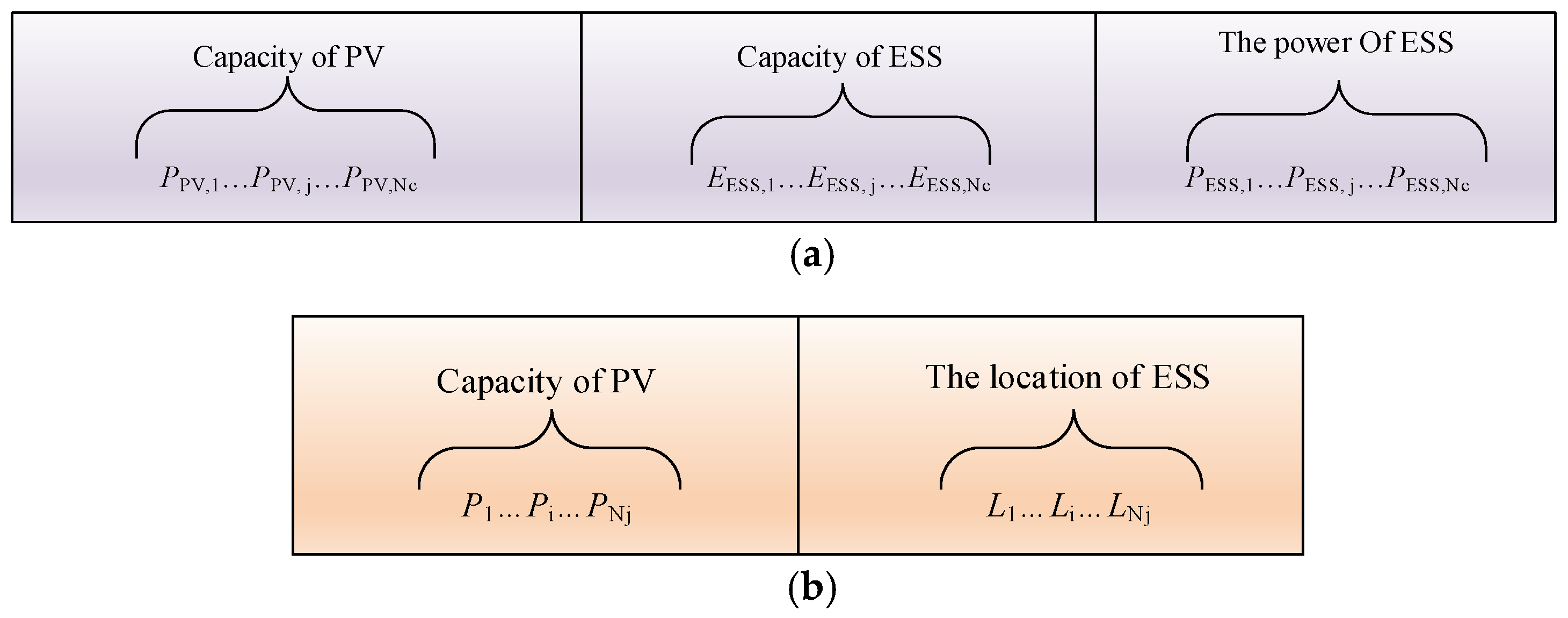

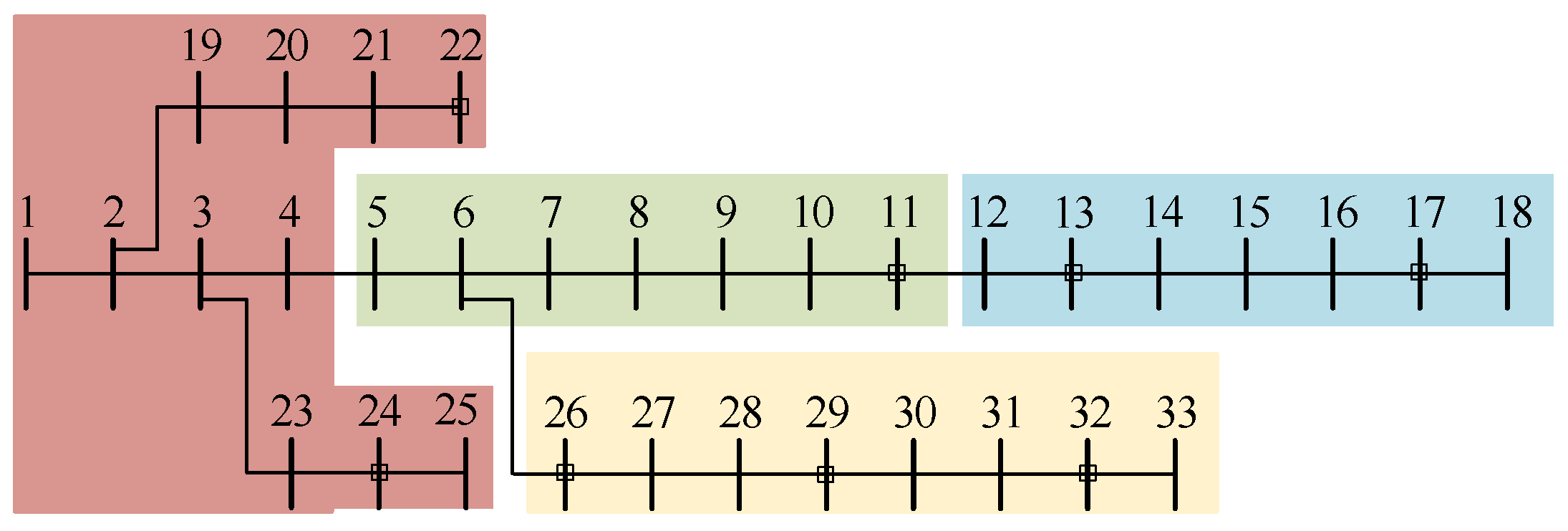
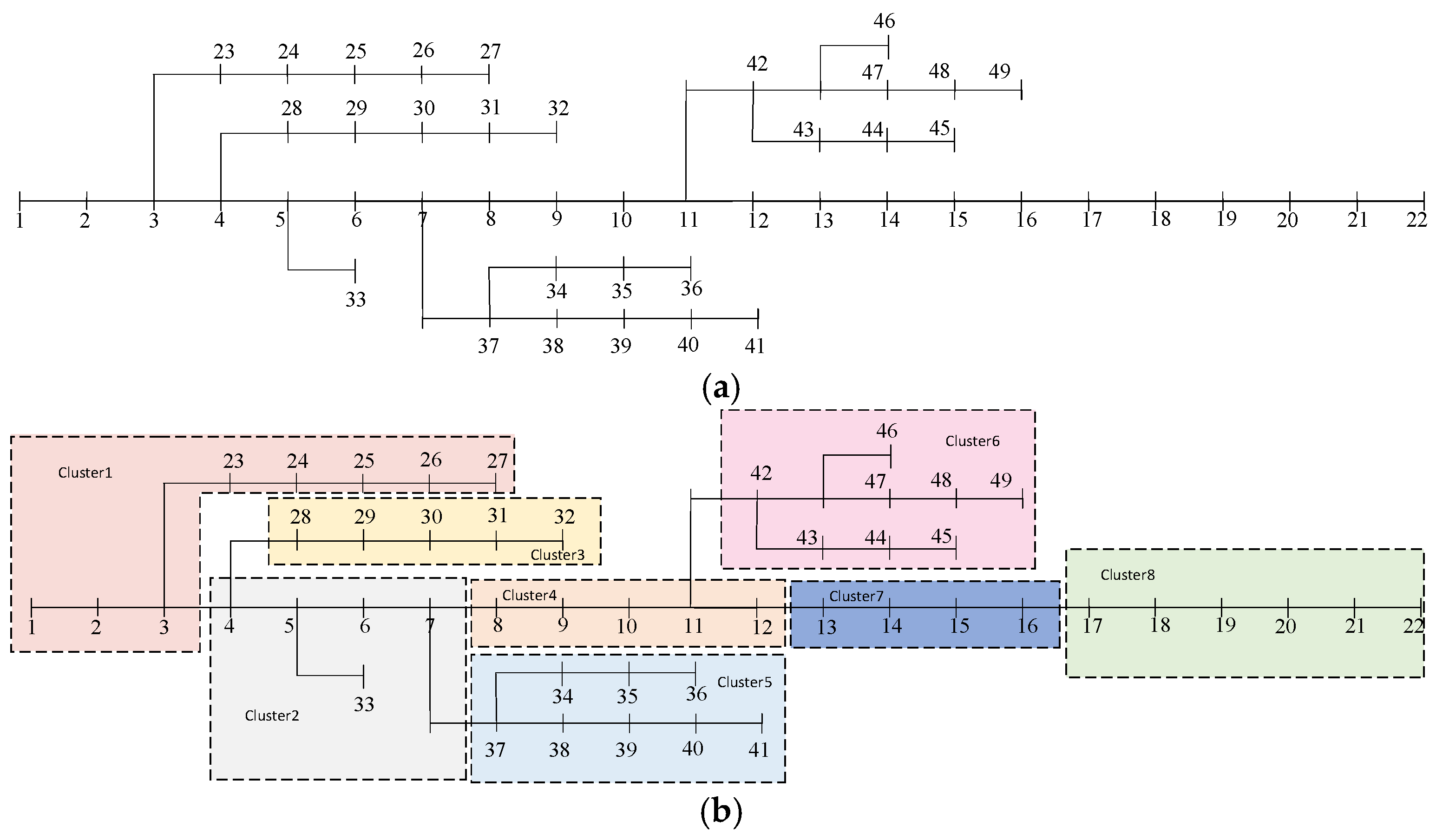
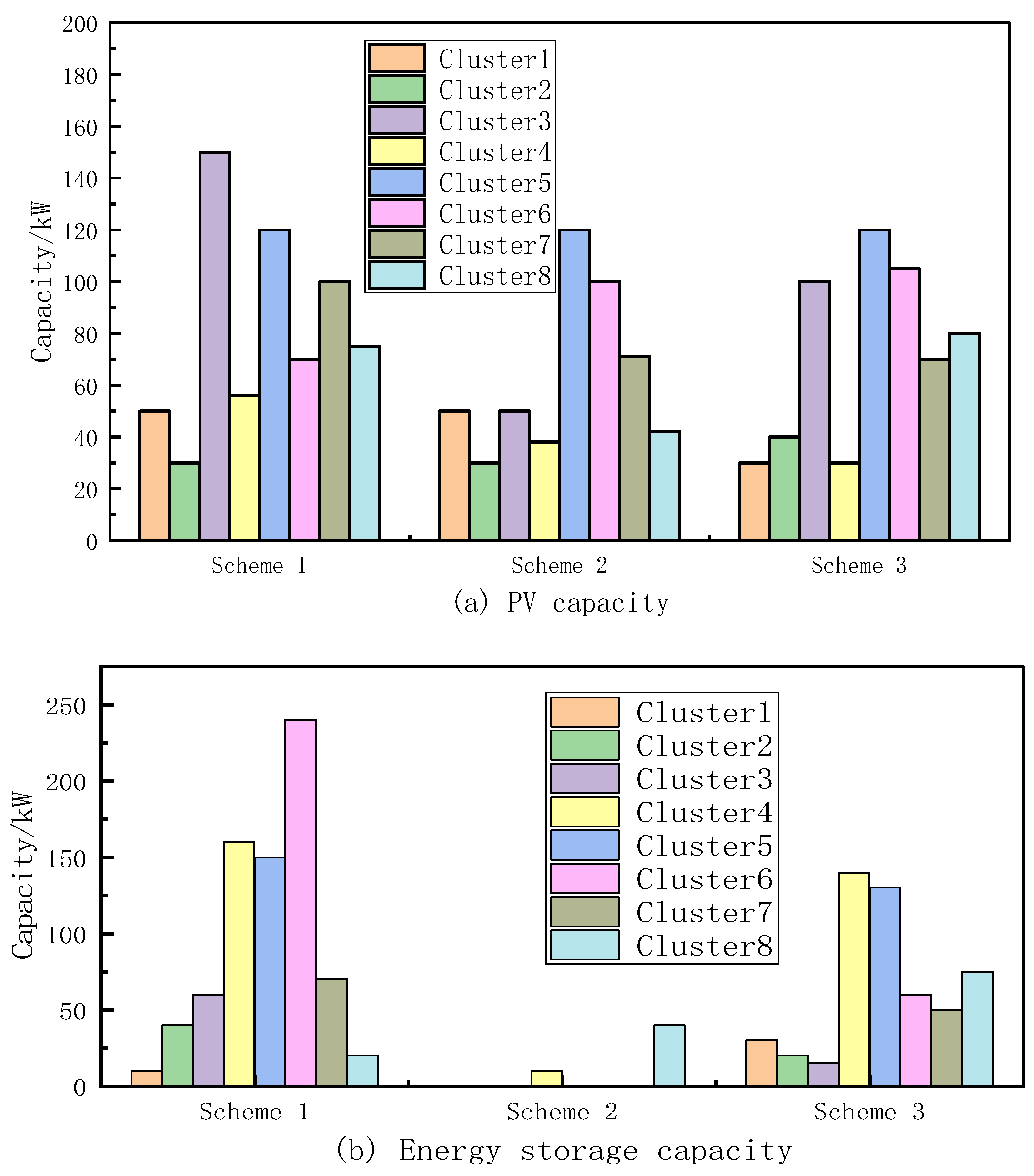

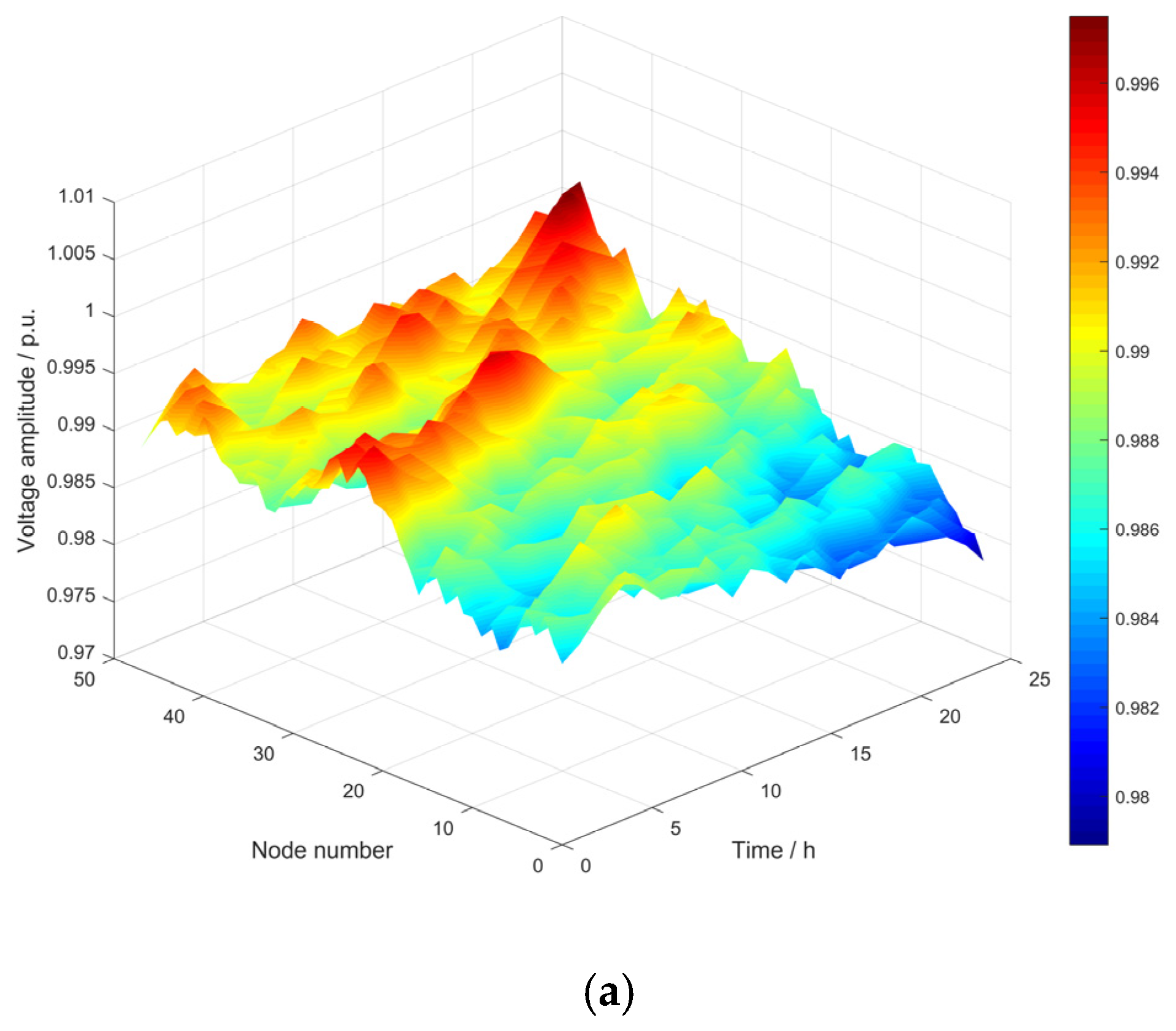
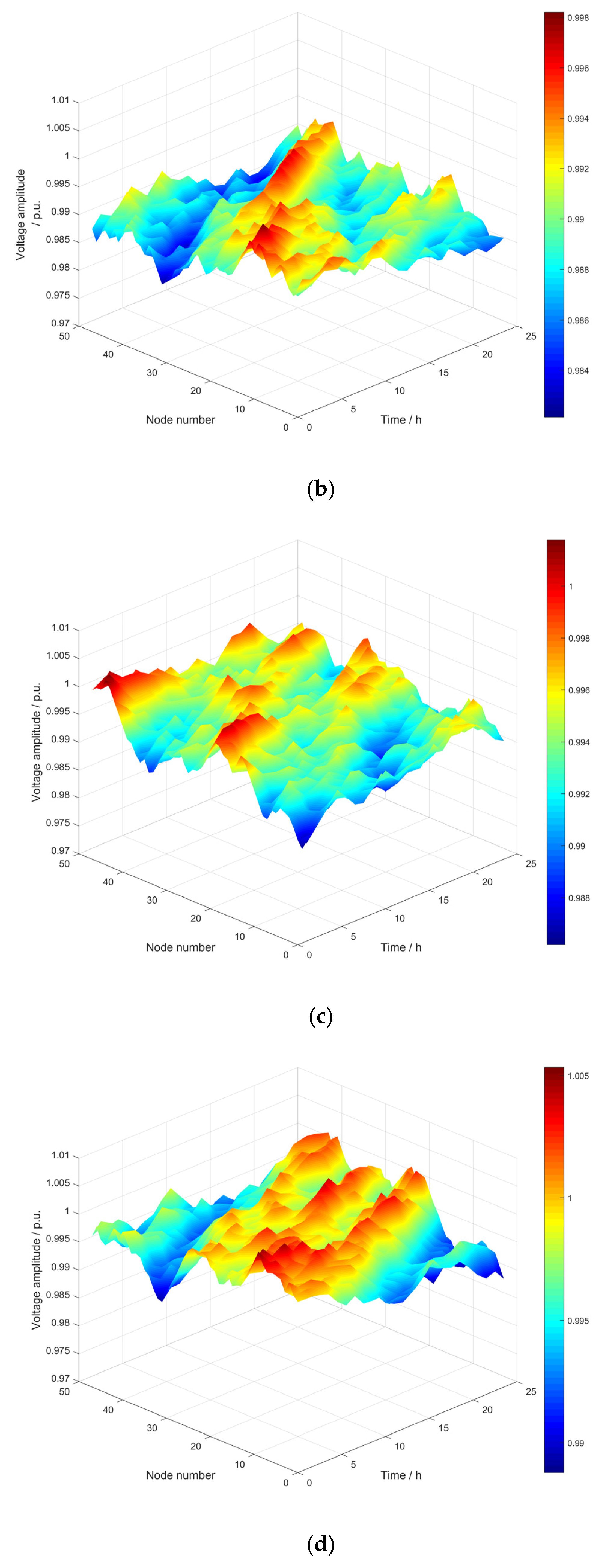
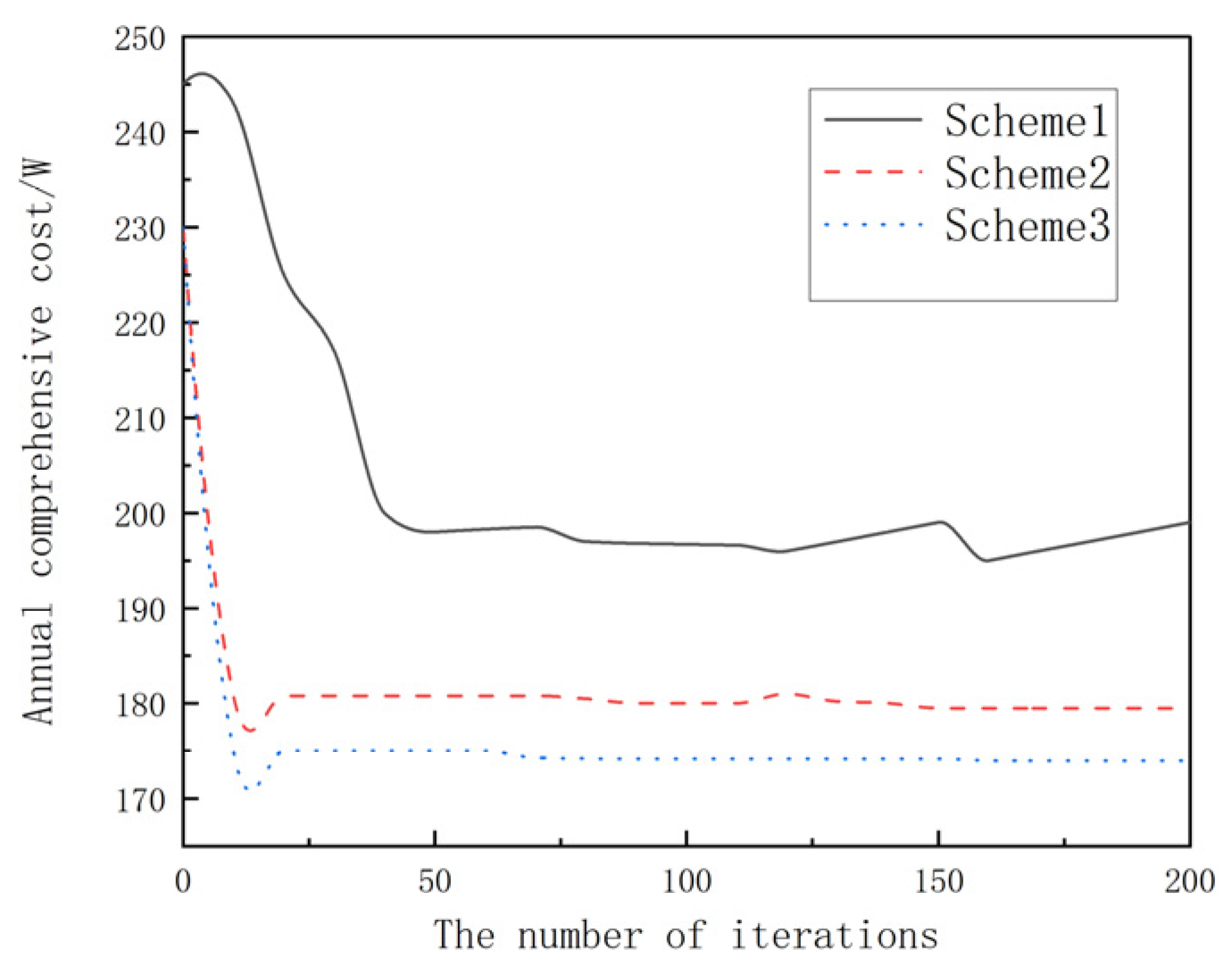


| Scheme | System Power Purchase Cost (USD) | Network Loss Cost (RMB) | Energy Storage Cost (RMB) | Comprehensive Cost (RMB) |
|---|---|---|---|---|
| Option 1 | 11,447.23 | 915.27 | — | 12,362.51 |
| Option 2 | 11,010.40 | 830.12 | 531.17 | 12,360.44 |
| Option 3 | 10,611.80 | 751.02 | 492.14 | 11,856.06 |
| Photovoltaic Permeability | System Power Purchase Cost (USD) | Network Loss Cost (USD) | Energy Storage Cost (USD) | Comprehensive Cost (USD) |
|---|---|---|---|---|
| 20% | 11,137.16 | 696.71 | 423.35 | 12,257.22 |
| 40% | 10,457.60 | 764.33 | 444.65 | 11,666.58 |
| 60% | 9777.05 | 835.71 | 488.21 | 11,091.98 |
| 80% | 9098.49 | 976.26 | 560.80 | 10,635.55 |
| Electricity Price Fluctuation Coefficient | Energy Storage System Configuration Capacity (kWh) |
|---|---|
| −20% | 1023.45 |
| −10% | 1198.76 |
| 0% | 1512.34 |
| +10% | 1789.01 |
| +20% | 2034.56 |
| Cost | Not Planned | Scenario 1 | Scenario 2 | Scenario 3 |
|---|---|---|---|---|
| Installation costs/USD | 0 | 56,355.86 | 32,718.91 | 57,826.59 |
| Operation and maintenance costs/USD | 0 | 33,670.32 | 33,509.67 | 35,127.20 |
| Photovoltaic power generation subsidy/USD | 0 | 49,551.99 | 45,782.38 | 62,536.53 |
| The cost of purchasing electricity on the main network/USD | 291,379.19 | 228,895.29 | 227,906.49 | 212,476.28 |
| Annual Composite Fee/USD | 291,379.19 | 259,185.14 | 247,264.19 | 243,717.54 |
| Cost | NaS | VRB | PSB | VRLA | Li-Ion |
|---|---|---|---|---|---|
| Installation costs | 33.468 | 40.012 | 67.942 | 30.451 | 29.487 |
| Operating and maintenance costs | 28.486 | 32.155 | 56.055 | 25.457 | 25.557 |
| Photovoltaic power generation subsidy | 37.487 | 46.344 | 69.645 | 37.264 | 40.158 |
| The expense of acquiring electricity from the main network | 164.893 | 157.264 | 124.256 | 168.144 | 168.758 |
| Annual Composite Fee | 187.575 | 184.488 | 177.548 | 187.481 | 187.044 |
| Cost | NaS | VRB | PSB | VRLA | Li-Ion |
|---|---|---|---|---|---|
| Cluster 1 | 16.712 | 14.242 | 9.314 | 15.241 | 15.769 |
| Cluster 2 | 1.485 | 1.123 | 0.154 | 1.678 | 1.641 |
| Cluster 3 | 3.613 | 3.314 | 2.369 | 3.647 | 3.364 |
| Cluster 4 | 1.548 | 1.345 | 1.205 | 1.648 | 1.345 |
| Cluster 5 | 1.597 | 1.354 | 1.315 | 1.487 | 1.645 |
| Cluster 6 | 0.647 | 0.478 | 0.563 | 0.347 | 0.148 |
| Cluster 7 | 1.264 | 1.971 | 1.481 | 1.147 | 1.369 |
| Cluster 8 | 0.647 | 0.478 | 0.648 | 0.347 | 0.414 |
| Intergroup | 6.674 | 6.654 | 3.547 | 6.678 | 6.344 |
| Total network loss | 32.672 | 30.648 | 22.254 | 32.415 | 32.544 |
| Algorithm | Calculation Time (Seconds) | Annual Comprehensive Cost (USD) |
|---|---|---|
| Hybrid Particle Swarm Optimization (HPSO) | 5.2 | 26.53 |
| Genetic Algorithm (GA) | 12.3 | 28.87 |
| Sequential Quadratic Programming (SQP) | 8.7 | 27.63 |
| T Reinforcement Learning Algorithm (DRL) | 15.6 | 29.80 |
Disclaimer/Publisher’s Note: The statements, opinions and data contained in all publications are solely those of the individual author(s) and contributor(s) and not of MDPI and/or the editor(s). MDPI and/or the editor(s) disclaim responsibility for any injury to people or property resulting from any ideas, methods, instructions or products referred to in the content. |
© 2025 by the authors. Licensee MDPI, Basel, Switzerland. This article is an open access article distributed under the terms and conditions of the Creative Commons Attribution (CC BY) license (https://creativecommons.org/licenses/by/4.0/).
Share and Cite
Liu, X.; Zhao, P.; Qu, H.; Liu, N.; Zhao, K.; Xiao, C. Optimal Placement and Sizing of Distributed PV-Storage in Distribution Networks Using Cluster-Based Partitioning. Processes 2025, 13, 1765. https://doi.org/10.3390/pr13061765
Liu X, Zhao P, Qu H, Liu N, Zhao K, Xiao C. Optimal Placement and Sizing of Distributed PV-Storage in Distribution Networks Using Cluster-Based Partitioning. Processes. 2025; 13(6):1765. https://doi.org/10.3390/pr13061765
Chicago/Turabian StyleLiu, Xiao, Pu Zhao, Hanbing Qu, Ning Liu, Ke Zhao, and Chuanliang Xiao. 2025. "Optimal Placement and Sizing of Distributed PV-Storage in Distribution Networks Using Cluster-Based Partitioning" Processes 13, no. 6: 1765. https://doi.org/10.3390/pr13061765
APA StyleLiu, X., Zhao, P., Qu, H., Liu, N., Zhao, K., & Xiao, C. (2025). Optimal Placement and Sizing of Distributed PV-Storage in Distribution Networks Using Cluster-Based Partitioning. Processes, 13(6), 1765. https://doi.org/10.3390/pr13061765




